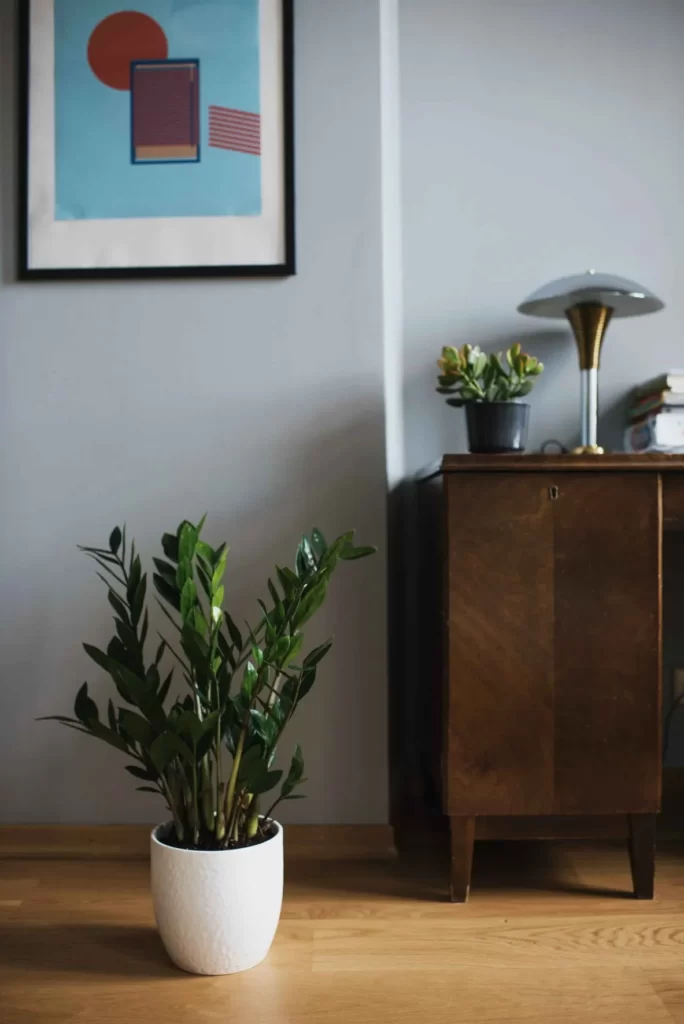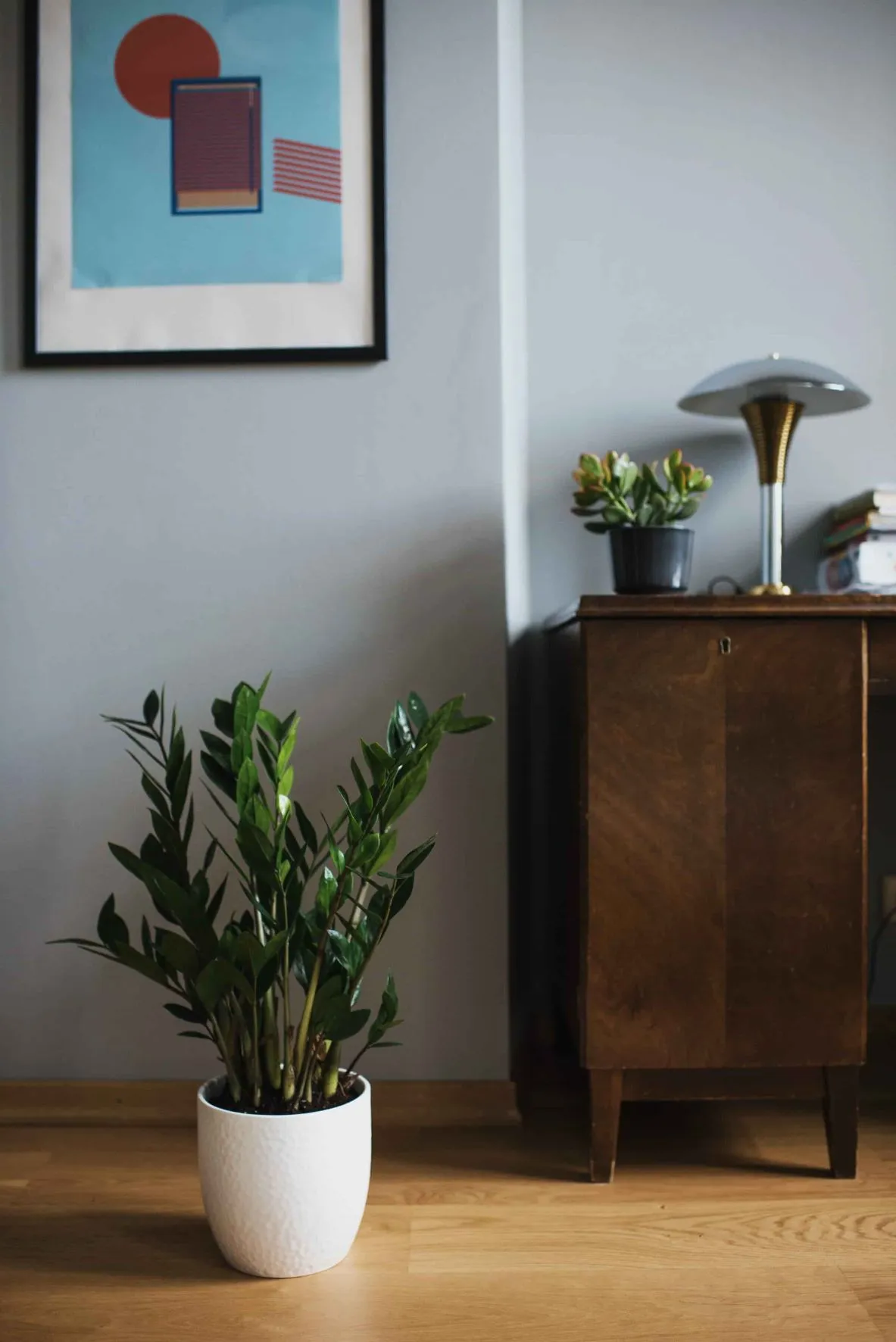ZZ plants (Zamioculas zamifolia) are an increasingly popular houseplant that can add a touch of beauty and life to any room or office.
As with all houseplants, proper care is key for ensuring a happy, healthy plant. One area that needs attention is the lighting requirements for the ZZ plant.
Understanding how much light the plant needs and providing it with the right conditions will ensure your ZZ plant thrives for many years to come.
How Much Light Does a ZZ Plant Need?
Like all plants, a ZZ plant requires adequate levels of light in order to survive and grow. The amount of light needed varies depending on the environment and location, but generally speaking, ZZ plants require medium to bright indirect sunlight in order to thrive.
They can also do well in partial shade or low-light situations as long as they’re not deprived of natural sunlight entirely.

Types Of Lighting
If you don’t have access to natural sunlight or indirect sunlight, there are artificial lighting options available for your ZZ plant.
Fluorescent lights are great for providing the correct spectrum of light necessary for photosynthesis and growth.
LED lights are another option—they’re more energy efficient than other types of bulbs but may require replacement more often due to their shorter lifespan.
Another option is compact fluorescent lights (CFL). These produce less heat than traditional bulbs while still providing adequate levels of light for your plants.
How Often Should I Use Artificial Light?
As a general rule of thumb, it is recommended to use artificial lighting for your ZZ plant every day from early spring through late fall.
For optimal growth and development, the plant should receive as much light as possible during this time. However, if you live in an area that does not have very many sunny days or if natural sunlight is not readily available for your plant, you can use artificial light sources.
This will ensure your ZZ plant continues to receive the correct light levels necessary for it to grow and thrive.
In a 24 hr. period, the best-growing temperature range is approximately 65-85°F (18°C to 29°C). The plant can survive just fine at higher or lower temperatures, however, it will grow less quickly.
Daily lighting for your ZZ Plant should be about eight hours with a natural decline in lumens over that time frame. The length of lighting time per day can be adjusted to increase or decrease the lumen output.
Read about ZZ plant leaves curling. Because it’s related to the light requirement.
Stressing Out Your Plant – How To Avoid It?
The most important thing to remember when it comes to lighting your ZZ plant is not to overdo it. Too much direct sunlight can cause the leaves to burn and turn brown or yellow—this indicates sunburned leaves due to too intense exposure.
If you notice this happening, move your plant out of the direct sun immediately and adjust the lighting accordingly so that it’s getting adequate amounts without being overexposed.
In addition, be sure not to leave your ZZ plant in one spot for too long without giving it a bit of respite from its current source of lighting.
This will help prevent depleted energy reserves from accumulating within its cells which could stress out the plant further by depriving it of essential nutrients needed for photosynthesis and growth processes.
Allowing your ZZ plant some time away from its current source of light every few days will help ensure optimal health and well-being for many years ahead!
Outdoor light requirements are much different than indoor exposure. A ZZ Plant will likely not survive in open, direct sunlight outdoors due to its inability to cope with high temperatures and low humidity levels.
If you do take your plant outside during a sunny day, it should only be for a few hours, and not in direct sunlight.
If you are able to provide your ZZ plant with adequate lighting conditions, you will likely notice healthier growth and an increase in its vibrancy.
Providing adequate light is one of the most important steps in ensuring your ZZ plant thrives. If you’re not sure whether or not your plant is getting enough light, look for signs of wilting.
This can be a clue that the plant isn’t receiving the right amount of light and may need to be moved to a brighter spot in your home or office.
You should also know about the ZZ plant soil mix recipe.
Conclusion
Now that you know what types of lighting work best for healthy, thriving indoor-grown ZZ plants as well as avoiding overexposure and stressing out the little one – you’ll be able to give them everything they need!
Keep in mind: appropriate amounts of either natural or artificial lighting make all the difference when it comes to keeping your beloved houseplant gracing any room with its presence!
ZZ Plant Light Requirements Related FAQs
How much light does a ZZ plant need?
ZZ plants thrive best in medium to bright indirect sunlight. They can also tolerate low-light conditions, but it’s essential not to deprive them entirely of natural sunlight. Avoid placing them in direct sunlight, as it can cause leaf burn.
Can ZZ plants grow in low light?
Yes, ZZ plants can grow in low-light environments, making them ideal for offices and rooms with minimal natural light. However, their growth rate may slow down in these conditions.
What type of artificial light is best for a ZZ plant?
Fluorescent lights, LED lights, and compact fluorescent lights (CFL) are all suitable options for providing artificial light to ZZ plants. Fluorescent and CFL bulbs offer the correct light spectrum needed for growth, while LEDs are energy-efficient and effective.
How many hours of artificial light does a ZZ plant need daily?
A ZZ plant should receive about eight hours of artificial light daily. Ensure the light source mimics natural light conditions, with a gradual decline in lumens over the day.
Can ZZ plants handle direct sunlight?
No, direct sunlight can damage ZZ plants, causing their leaves to burn and turn brown or yellow. It’s crucial to keep them in indirect sunlight or shaded areas to prevent sunburn.
What should I do if my ZZ plant gets too much light?
If you notice your ZZ plant’s leaves turning brown or yellow, it may be getting too much light. Move the plant to a spot with less direct exposure and adjust the lighting to prevent further damage.
Can I move my ZZ plant outdoors?
While ZZ plants can be placed outdoors for short periods, they should not be exposed to direct sunlight or extreme temperatures. If placed outside, ensure they are in a shaded area and bring them back indoors after a few hours.
How can I tell if my ZZ plant isn’t getting enough light?
Signs that your ZZ plant isn’t receiving enough light include wilting, slow growth, and pale or yellowing leaves. If you observe these symptoms, move your plant to a brighter location with more indirect light.
What is the ideal temperature range for growing ZZ plants?
The ideal temperature range for growing ZZ plants is approximately 65-85°F (18°C to 29°C). While they can survive in higher or lower temperatures, they may grow less quickly outside of this range. Maintaining temperatures within this range can promote optimal growth and overall health for your ZZ plant.
How often should I rotate my ZZ plant to ensure even light exposure?
Rotating your ZZ plant every 1-2 weeks is beneficial to ensure even light exposure on all sides of the plant. This helps prevent uneven growth and encourages balanced development.
Can I use a timer for artificial lighting with my ZZ plant?
Yes, using a timer for artificial lighting can be convenient and ensures consistent light exposure for your ZZ plant. Set the timer to provide around 8 hours of artificial light per day, mimicking natural daylight cycles.
Should I place my ZZ plant near a window with sheer curtains for filtered sunlight?
Yes, placing your ZZ plant near a window with sheer curtains can provide filtered sunlight, which is ideal for ZZ plants. Ensure the curtains filter out harsh direct sunlight, preventing leaf burn while still allowing sufficient light for photosynthesis.
Can I use grow lights specifically designed for indoor plants with my ZZ plant?
Yes, using grow lights designed for indoor plants can be beneficial for ZZ plants, especially in low-light environments. Opt for full-spectrum grow lights to mimic natural sunlight and promote healthy growth.
How can I prevent my ZZ plant from leaning towards the light source?
To prevent your ZZ plant from leaning towards the light source, rotate it regularly to promote even growth. Additionally, ensure the light source is positioned directly above the plant or use multiple light sources to distribute light evenly.
Can I supplement natural light with artificial light for my ZZ plant?
Yes, supplementing natural light with artificial light can be beneficial, especially in areas with limited sunlight. Use artificial lighting to provide consistent light levels and ensure optimal growth for your ZZ plant.
Is it okay to place my ZZ plant under fluorescent office lighting?
Yes, ZZ plants can tolerate fluorescent office lighting, but it’s essential to ensure they receive sufficient light levels. Position the plant within a few feet of the fluorescent lights to maximize light exposure and promote healthy growth.
Will my ZZ plant thrive in a room with only artificial lighting?
While ZZ plants can survive in rooms with only artificial lighting, they may not thrive as well as in natural light. Ensure the artificial lighting provides sufficient intensity and duration to support the plant’s growth needs.
Can I use a combination of natural and artificial light for my ZZ plant?
Yes, using a combination of natural and artificial light can provide the best of both worlds for your ZZ plant. Supplement natural light with artificial lighting as needed to ensure consistent and adequate light levels throughout the day.
Can I use a light meter to measure light intensity for my ZZ plant?
Yes, using a light meter can help you determine if your ZZ plant is receiving sufficient light intensity for optimal growth. Aim for light levels between 75 to 200 foot-candles for ZZ plants, adjusting artificial lighting as needed.
How can I acclimate my ZZ plant to new lighting conditions?
To acclimate your ZZ plant to new lighting conditions, gradually introduce it to the new environment over a period of 1-2 weeks. Start with shorter exposure periods and gradually increase the duration and intensity of light to prevent shock and stress to the plant.

